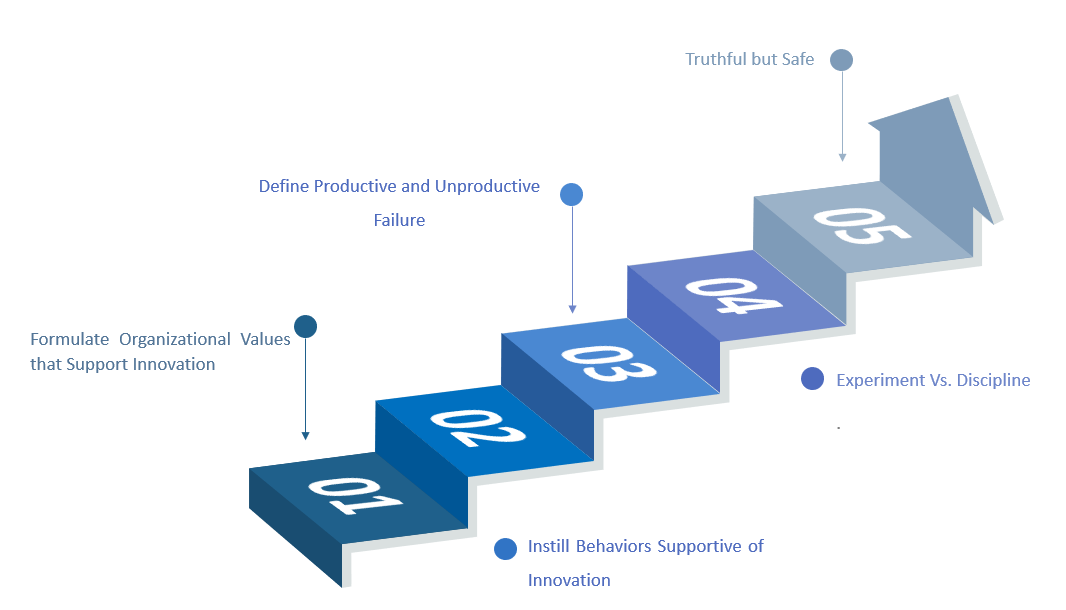5 Steps to Build a Culture of Innovation

1. Formulate Organizational Values that Support Innovation
What is the corporate value that fosters innovation? What does the company consider to be true at its core? What are our corporate philosophy and moral compass? A few examples are openness, sharing, teamwork, risk-taking, adoring mavericks, and praising failure. Also, values are how a company spends its money and how and where its executives spend their time, not what we say in our speeches and annual reports. Companies such as J&J, Southwest Airlines, Wal-Mart, and IDEO are instances of this.
2. Instill Behaviors Supportive of Innovation
To stimulate creativity, how do we think, approach, and act? Being opportunistic, adaptable, adaptive, collaborative, resilient, making daring judgments in the face of uncertainty, and dealing with ambiguity are all examples of behaviors. These behaviors may be learned, practiced, and coached, and best of all, there is no need for a budget or permission. IDEO, Google, 3M, and Wal-Mart are just a few examples.2
3. Define Productive and Unproductive Failure
In firms with neither history, it is challenging to create a culture that values learning through failure and outstanding achievement. An excellent place to begin is for senior management to define the distinction between productive and unproductive failures: In comparison to their cost, productive failures provide helpful information. Only if a failure resulted in learning should it be applauded. The phrase "applauding failure" is misleading; we should celebrate learning, not failure. If the new knowledge can be applied to future designs, a basic prototype that fails to work as planned due to a previously unforeseen technological flaw is a failure worth celebrating. 3
4. Experiment Vs. Discipline
Being eager to try new things does not mean you have to work like a third-rate abstract painter who splashes paint on a canvas at random. Almost anything may be justified as an experiment if there is no discipline. Experiments in discipline-oriented cultures are carefully chosen based on their potential learning value, and they are meticulously designed to give as much information as feasible compared to the expenses. They establish explicit criteria for selecting whether to pursue, modify, or abandon a concept from the start. They also have to deal with the results of experiments.
5. Truthful but Safe
We all want to be heard and have the ability to speak our thoughts without fear, but psychological safety is a two-way street. It must be safe for you to criticize my ideas if I do so—whether you are higher or lower in the organization than I am. Because it is the mechanism by which ideas evolve and improve, unvarnished honesty is crucial to invention. People in some organizations are pretty comfortable challenging one another's ideas, techniques, and outcomes. People are expected to be able to back up their claims with evidence or logic.
1Dicere Global, 26 Oct 2021, Zuloaga Imatge, 6 Building Blocks for an Innovation Culture, Accessed 30 Sep 2021, http://dicereglobal.com/6-building-blocks-to-create-an-innovation-culture/
2Dicere Global, 26 Oct 2021, Zuloaga Imatge, 6 Building Blocks for an Innovation Culture, Accessed 30 Sep 2021, http://dicereglobal.com/6-building-blocks-to-create-an-innovation-culture/
3HBR, Jan-Feb 2019, Gary P. Pisano, The Hard Truth about Innovative cultures, Accessed 30 Sep 2021, https://hbr.org/2019/01/the-hard-truth-about-innovative-cultures
For more about this topic, download our latest book " Business Models: Survive and Thrive " for FREE:
